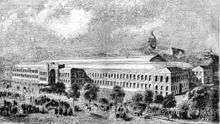Exposition Universelle (1855)
The Exposition Universelle of 1855 was an International Exhibition held on the Champs-Élysées in Paris from 15 May to 15 November 1855. Its full official title was the Exposition Universelle des produits de l'Agriculture, de l'Industrie et des Beaux-Arts de Paris 1855.[1] Today the exposition's sole physical remnant is the Théâtre du Rond-Point des Champs-Élysées designed by architect Gabriel Davioud, which originally housed the Panorama National.
| Exposition Universelle des produits de l'Agriculture, de l'Industrie et des Beaux-Arts de Paris 1855 | |
|---|---|
 Palais de l'industrie | |
| Overview | |
| BIE-class | Universal exposition |
| Category | Historical Expo |
| Name | Exposition Universelle des produits de l'Agriculture, de l'Industrie et des Beaux-Arts de Paris 1855 |
| Building | Palais de l'Industrie |
| Area | 15,2 ha |
| Visitors | 5,162,330 |
| Participant(s) | |
| Countries | 27 |
| Location | |
| Country | France |
| City | Paris |
| Venue | Jardins des Champs Elysees |
| Coordinates | 48°52′0″N 2°18′47″E |
| Timeline | |
| Opening | 15 May 1855 |
| Closure | 15 November 1855 |
| Universal expositions | |
| Previous | The Great Exhibition in London |
| Next | 1862 International Exhibition in London |
History
The exposition was a major event in France, then newly under the reign of Emperor Napoleon III.[2] It followed London's Great Exhibition of 1851 and attempted to surpass that fair's Crystal Palace with its own Palais de l'Industrie.
The arts displayed were shown in a separate pavilion on Avenue Montaigne.[3] There were works from artists from 29 countries, including French artists Francois Rude, Ingres, Delacroix[3] and Henri Lehmann,[4] and British artists William Holman Hunt and John Everett Millais.[3] However, Gustave Courbet, having had several of his paintings rejected, exhibited in a temporary Pavillon du Réalisme adjacent to the official show.
According to its official report, 5,162,330 visitors attended the exposition, of whom about 4.2 million entered the industrial exposition and 0.9 million entered the Beaux Arts exposition.[1] Expenses amounted to upward of $5,000,000, while receipts were scarcely one-tenth of that amount. The exposition covered 16 hectares (40 acres) with 34 countries participating.[1]
For the exposition, Napoleon III requested a classification system for France's best Bordeaux wines which were to be on display for visitors from around the world. Brokers from the wine industry ranked the wines according to a château's reputation and trading price, which at that time was directly related to quality. The result was the important Bordeaux Wine Official Classification of 1855.[5]
References
- Exposition Universelle. "1855, exposition universelle des produits de l'agriculture, de l'industrie et des beaux-arts". Exposition Universelle. Retrieved 9 January 2012.
- Art Nouveau. "L' Exposition Universelle de 1855 à Paris". L'art nouveau. Retrieved 9 January 2011.
- Ratcliffe, Barrie M. "Paris 1855". In Findling, John E.; Pelle, Kimberley D. (eds.). Encyclopedia of World's Fairs and Expositions. McFarland & Company, Inc. p. 23. ISBN 978-0-7864-3416-9.
- Océanides grief of the foot of the rock where Prometheus was chained, Fitzwilliam Museum, 2014
- Peppercorn, David (2003). Bordeaux. London: Mitchell Beazley. p. 83. ISBN 1-84000-927-6.
Further reading
- Elizabeth M. L. Gralton, 'Lust of the Eyes: The Anti-Modern Critique of Visual Culture at the Paris Expositions universelles, 1855–1900', French History & Civilization (2014), Vol. 5, pp 71–81.
- This article incorporates text from a publication now in the public domain: Gilman, D. C.; Peck, H. T.; Colby, F. M., eds. (1905). New International Encyclopedia (1st ed.). New York: Dodd, Mead. Missing or empty
|title=(help)
External links
| Wikimedia Commons has media related to Exposition Universelle (1855). |